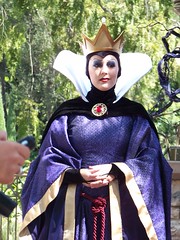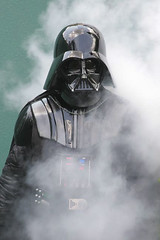We’re still on break from our series on plotting to bring you notes from The Book Academy, a conference I attended last week. We’ll pick up with plotting tomorrow—including a guest post later this week!
In suspense, you have to have a villain. You have to have a person who is fighting against a protagonist.
Exercise #1—Write down a villain who stands out on some level to you—and why
Class answers:
- President Snow from Hunger Games? Description—smells like roses and blood
- Hannibal Lecter—creepy, without morals
- Brilliant manipulator
- Gollum—obsessed, internal conflict
- Darth Vader—layered, conflicted, simple appearance, memorable, willing to do what it takes to get his way
- Nicholas Nickleby’s villain—Heartless, but there’s a moment in his past where he chose darkness
- Voldemort
- Javert—thinks he’s good, convinced of morality
- Joker—flair for dramatic, feel emotional connection as killing, loved that connection
- Clooney the scourge from Redwall—legend of fearsomeness, backs it up, crazy
- Oliver Twist villain—utter disregard for reader’s sympathies
- David Copperfield villains—bad, love to hate
 “You have a choice when you’re going to introduce a very evil character. You can dress a guy up with loads of ammunition, put a black Stetson on him, and say, ‘Bad guy. Shoot him.’ I’m writing about shades of evil. You have Voldemort, a raging psychopath, devoid of the normal human responses to other people’s suffering, and there are people like that in the world. But then you have Wormtail, who out of cowardice will stand in the shadow of the strongest person.” —JK Rowling
“You have a choice when you’re going to introduce a very evil character. You can dress a guy up with loads of ammunition, put a black Stetson on him, and say, ‘Bad guy. Shoot him.’ I’m writing about shades of evil. You have Voldemort, a raging psychopath, devoid of the normal human responses to other people’s suffering, and there are people like that in the world. But then you have Wormtail, who out of cowardice will stand in the shadow of the strongest person.” —JK Rowling
How compelling your villain is doesn’t depend on how creepy and freaky he is, but that he seems real to your protagonist, and as real as your protagonist to your reader. They must also fit your story. A cozy mystery probably doesn’t need Voldemort. A global thriller probably wouldn’t be very thrilling with the biddies from Arsenic and Old Lace.
We can also have multiple villains in same novel with multiple levels of villainy:
- Voldemort
- Bellatrix LaStrange
- Peter Pettigrew/Wormtail
- Draco Malfoy
- Severus Snape
Hints for creating villainous characters
In suspense fiction, plenty of people are causing trouble for your villain, but pick a primary villain. Find the main antagonist. Who’s your big guy? In mysteries, think about who this fight is really between.
Jack Bickham talks about how you must know whose story it is. (In her first novel, 250 single-spaced pages into it, she realized her story was going off in 3 different directions—she turned to Bickham). Don’t forget whose story it is. Who are we behind? Who are we rooting for? Who is our ball team?
On the flip side, whose story is this villainwise? Your protagonist has a story goal, something he wants from the beginning of the book. It’s important to him, important enough to fight for. It gives readers something to worry about (which is why they like reading mysteries in the first place). When you read a book with a story goal, you immediately start asking yourself story questions. Frodo must destroy the ring—will Frodo be able to destroy the ring?
In addition to your protagonist, your villain also needs to be goal-driven. He’s got something that he wants. When you’re picking a villain, you want it to be someone who will win or lose big depending on how the story plays out, just like the protagonist has a lot invested in whatever s/he is seeking. Winning and losing—if one wins, the other must lose.
Creating conflict in your novel
The last thing you want to do is give your protagonist an easy ride. Give him as much trouble as possible. If you answer the story question too quickly with a positive, the story’s over.
Shortest stories ever:
He always wanted her. And he got her.
She had to escape. And she did.
These complications are largely the job of the villain.
- Pick a good, strong primary villain. Someone who can really go head to head with the protagonist.
- Villain’s goal must clash with protagonist’s goal—so give one a goal and find a contrary goal for the other. This isn’t necessarily a direct opposition. Her current novel—protagonist’s story goal: heal the rift between her parents and her brother. This clashes with villain’s goal not because villain is set on destroying their family. His goal is to conceal a crime in his past (by killing someone and framing someone else—her brother). (Being accused of murder doesn’t sit real well with her parents, “who are strangely traditional in that way.”)

- What does my villain want?! What is important to him/her? A really compelling villain isn’t evil for evil’s sake or because he’s got the laugh down. Chances are he doesn’t think he’s evil. He’s got a reason for everything. Jack Bickham: Self-concept. Inside, we all have a mental picture of who we are, our opinions of ourselves. We try hard to maintain consonance with this inward picture and we will fight to hold onto it when this picture is challenged. Hard to identify it for ourselves. What does the villain think of himself?
- Usually villains are twisted on some level—his self-concept may be very different from how others view him. Ex: Zero in The Believer—he sees himself as someone who by virtue of lineage/intelligence, he has the right and responsibility to take over for the good of the nation. Doesn’t see himself as evil (though readers and other characters do). Villain in Fool Me Twice sees herself as a good mother. Have this in mind even if it doesn’t make it into print (especially if not in their POV).
Exercise #2—Write down a self-concept for a villain (one you’re working on)
Class responses:
- Believes he should be a leader
- Doesn’t believe in right/wrong
- Humanity has outlived its purpose, cleanse the world of this scourge
- (Possessed) Dark spirit protecting itself—self-preservation
- Religion—convinced of his own moral righteousness
- Sees the world crumbling around him—protect what he has and his fam
- Get justice for the wrongs he’s suffered (victim)
- Sees himself as a good guy
- The best at what he does and he knows it, and gets away with what he wants b/c people are scared of him—devolves into fatal stalking situation
Your main villain (amidst others if you desire)
- Give your villain some shading—make them somewhat sympathetic. Use their backstory, events taking place before the present of the story. What’s their history? Make villain more rounded, even if you don’t get it all in there.
 Ex: Voldemort—what makes you sympathize with him a little: Abandoned, orphan, stuck out, teased. Doesn’t justify his actions, but helps us to see him as a little more human. What might make the reader relate to him a little bit? See him as a little sympathetic?
Ex: Voldemort—what makes you sympathize with him a little: Abandoned, orphan, stuck out, teased. Doesn’t justify his actions, but helps us to see him as a little more human. What might make the reader relate to him a little bit? See him as a little sympathetic?
Ex: Darth Vader in episodes I-III—starts out as a good guy, through his flaws and downfall, he loses everything that he valued, then becomes a dark evil person.
Give them a little bit of good. Zero—loves his wife, affectionate toward her, wants to please her. Even villainous types aren’t totally detestable. What about them can we admire?
Exercise #3—with the last villain, write down something good/admirable about your villain or something in his/her past that might make him sympathetic
Class responses:
- (#5 above)—his parents disgusted at his parents, humans butcher his kind—thinks humans are no good
- (#6 above)—Mother deprived of rightful throne
- can’t die
- Wants to be a pillar of the community—wants to look good—funds schools
- Didn’t choose to be an addict
- Weakness/soft spot for kids.
- Hates weakness, but wants help people become better, lose their weaknesses
[Side note on this one: this is especially effective when you can combine this with their self-concept and have it directly relevant to their villany. For example, Snape is mean to Harry because in Harry he sees the image of the man who used to taunt him and destroy his self-concept. It wouldn’t make much sense if James Potter were mean to Snape and Snape took it out on long-haul truck drivers.]
Round them out with regular traits (neither sympathetic nor evil).
We have to branch out a bit. As you’re creating a protagonist, you want to create a fresh, compelling invidividual character with his own personality—same for his villain. [A good villain makes a good protagonist even stronger, and vice versa.]
- Three necessary attributes for principle villain:
He must be matched against the hero—a worthy opponent. Make him a worthy opponent—a battle with a wimp isn’t much of a battle. Your protagonist must stretch himself to defeat this guy. Doesn’t always mean villain is physically strong—psychologically, emotionally, mentally—a formidable opponent. He’s determined—what he wants, he must want it badly enough to not give up.
Bickham(?)—make sure your protagonist doesn’t quit and making it logical that he doesn’t quit. Ask yourself “Why doesn’t he just quit?”—compelling motivation to keep him going, keep fighting even when things get really rough. Villain who’s willing to keep battling to the end—don’t go all fuzzy at the end. Maybe pretend to, but don’t just give up!! [That’s just unsatisfying!]
He doesn’t have to be invincible—you do want him defeated at the end. Suspense/thriller/mystery—must end with good triumphing over evil! Have him defeated in some measure by the protagonist.
Ex: woman pursuing bad guy to get her kidnapped kids back. Fight scene, villain pulls weapon about to use it—struck by lightning. [Unsatisfying again!]
Don’t have him defeated by wimpiness, giving up (himself), deus ex machina.
- Give your villain believable flaws and weaknesses. It’s okay if he makes mistakes—but make sure they’re credible mistakes. Something believable, credible for his character. His flaws may spring from his self-concept—thinks he’s so smart, he’s proud—underestimates protagonist.
 Ex in The Believer—a reader for her publisher asked if her villain’s monologuing was believable? But according to his motivation, yes—if he’s so proud of himself and his win, he might monologue, to utterly devastate the hero. (And because he tells his plan, the protagonist can defeat him.)
Ex in The Believer—a reader for her publisher asked if her villain’s monologuing was believable? But according to his motivation, yes—if he’s so proud of himself and his win, he might monologue, to utterly devastate the hero. (And because he tells his plan, the protagonist can defeat him.)
- Give your villain a character arc—let him change throughout the course of the story. How does he grow and change? Don’t make him the same person on the last page as he was on page one.
Ex: one of her villain starts off not so bad, kind of mischievous, but by the end of the book she’s ready to kill.
Conclusion: You create compelling villains the same way you create compelling protagonists:
Make them real, make them rounded, give them a compelling story goal and believable flaws and weaknesses.
About the presenter
Stephanie Black is the author of The Believer, Fool Me Twice (winner of the 2008 Whitney Award for Best Mystery/Suspense) and the new release Methods of Madness. She. Is. Awesome. As per conference guidelines, I obtained written consent from Stephanie to blog the content of her presentation.
What do you think? What are your answers to the exercises? Who are your villains?
Photo credits: black cowboy hat—arbyreed; Wicked Queen—Loren Javier; Darth Vader—the Official Star Wars Blog; Villains—Anne the Librarian
 I know some people do just that—spend hours, days or even months designing a character and bringing him or her to life, tweaking every last nuance of his or her backstory, weaving it into the plot outline, crafting quirks, homing in on weaknesses—all before they start writing a word of the first draft.
I know some people do just that—spend hours, days or even months designing a character and bringing him or her to life, tweaking every last nuance of his or her backstory, weaving it into the plot outline, crafting quirks, homing in on weaknesses—all before they start writing a word of the first draft. 

 However, in character-driven fiction, the character arc is central. Reading this kind of fiction enables us the live character’s experiences and feelings, and those are at least as important to the story as the actual actions.
However, in character-driven fiction, the character arc is central. Reading this kind of fiction enables us the live character’s experiences and feelings, and those are at least as important to the story as the actual actions. For example, if we need our character to go from shocked after the last disaster to furious in the sequel, we start with that initial emotional response—the shock. We don’t have to spend a long time exploring the shock, especially if that’s the kind of reaction you’d expect in light of the disaster. Once we create a vivid picture of the shock (and that’s a toughie, since it’s characterized by the absence of feeling, really), we can give the character a minute to get her bearings again.
For example, if we need our character to go from shocked after the last disaster to furious in the sequel, we start with that initial emotional response—the shock. We don’t have to spend a long time exploring the shock, especially if that’s the kind of reaction you’d expect in light of the disaster. Once we create a vivid picture of the shock (and that’s a toughie, since it’s characterized by the absence of feeling, really), we can give the character a minute to get her bearings again.




